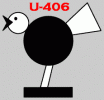-
 The Use Of Feinzink
The Use Of Feinzink
Hi, does anybody know the year that German badge/medal production moved over to 'Feinzink'? Cheers, Richard.
-
11-03-2010 10:03 PM
# ADS
Circuit advertisement

-
 Re: The Use Of Feinzink
Re: The Use Of Feinzink
Richard, all I do know is that it would seem Feinzinc (Fine zinc,nearly pure zink) light/silvery grey in colour was adopted as the war progressed (other metals needed in war production), later progressing to mid zink ( zinc with around 10% lead) this was medium to dark grey and then finally by late war in order to stretch out the supply of zinc came Kriegsmetal ( zinc with 30%+ lead, known as monkey metal or war metal) being a very dark almost black colour (suffers deterioration due to bloom), as for the precise dates I am unaware. The switchover which happened in the Second World War had occurred in the First World War, the switch overdate being 1916. Also be aware that many badges/awards were being made of Cupal, a far superior alternative to Kriegsmetal.
Prost ! Steve.
-
 Re: The Use Of Feinzink
Re: The Use Of Feinzink
Thanks steve, all I can find in the books etc is mid war. I suppose it may have been a gradual process with makers changing gradually, cheers, Richard.
-
-
 Re: The Use Of Feinzink
Re: The Use Of Feinzink
Great explanation Steve!
As you state, there was no tombak one day, zinc the next and there were several different types of zinc alloy used with varying degrees of quality. Zinc is an easy term to use to bracket several types of metal into one, although not strictly accurate.
 Looking for LDO marked EK2s and items relating to U-406.....
Looking for LDO marked EK2s and items relating to U-406.....
-
 Re: The Use Of Feinzink
Re: The Use Of Feinzink
Thanks Adrian, sorry to have impeded on your forum, but this scenario was also played out as the first War progressed and Imperial Germany found itself in pretty much the same position as the latter TR, with regards to commodities, so I like to think theres a common link here...in a way.
Prost ! Steve.
-
 Re: The Use Of Feinzink
Re: The Use Of Feinzink
No need to apologise Steve, your input is always valued and you explained it far better than I could.
 Looking for LDO marked EK2s and items relating to U-406.....
Looking for LDO marked EK2s and items relating to U-406.....
-
 Re: The Use Of Feinzink
Re: The Use Of Feinzink
Zinc was not only adopted in Germany but in several other counties for coinage,
and in both wars as well.
TR coins (1,2,5 and 10 Pfennig - 50Pf was aluminum) appeared early in the war (1940)
and were coated with a fine silver 'plating' which wore off very quickly - the same way
that coatings have faded from some later WWII medals, ie: Ostfront, KVK,
KVK1, Westwall, etc..........
-
 Re: The Use Of Feinzink
Re: The Use Of Feinzink

by
oradour

Richard, all I do know is that it would seem Feinzinc (Fine zinc,nearly pure zink) light/silvery grey in colour was adopted as the war progressed (other metals needed in war production), later progressing to mid zink ( zinc with around 10% lead) this was medium to dark grey and then finally by late war in order to stretch out the supply of zinc came Kriegsmetal ( zinc with 30%+ lead, known as monkey metal or war metal) being a very dark almost black colour (suffers deterioration due to bloom), as for the precise dates I am unaware. The switchover which happened in the Second World War had occurred in the First World War, the switch overdate being 1916. Also be aware that many badges/awards were being made of Cupal, a far superior alternative to Kriegsmetal.
Prost ! Steve.
Nicely stated Steve 
Nick

"In all my years as a soldier, I have never seen men fight so hard." - SS Obergruppenfuhrer Wilhelm Bittrich - Arnhem
-
 Re: The Use Of Feinzink
Re: The Use Of Feinzink
Hi Richard, this is a good question.
There were official restrictions placed upon use of various strategic materials starting in the late 1930's. As the country moved to a war economy these changes accelerated.
Cheers, Ade.

Bookmarks